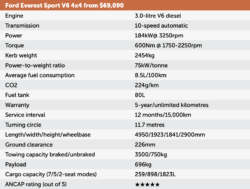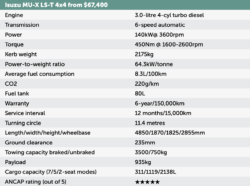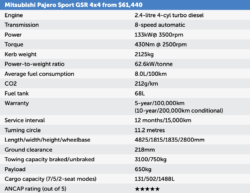The redesigned Ford Everest squares off against two favourites – the suave Isuzu D-Max and affordable Mitsubishi Pajero Sport. Byron Mathioudakis checks out the pros and cons.
The Contenders as driven:
Ford Everest Sport V6 4×4 from $69,090: Sophisticated and dynamic; Isuzu MU-X LS-T 4×4 from $67,400: An impressive all-rounder; and Mitsubishi Pajero Sport GSR 4×4 from $61,440: Oldie but a goodie.
Sometimes seats are just as important as space. That’s why tough ute-based wagons are strong sellers in Australia, especially for tradies who need a do-anything/go-anywhere workhorse that also doubles as a dependable family truckster.
And that is what the Ford Everest, Isuzu MU-X and Mitsubishi Pajero Sport have in common.
Each is derived from a midsized pick-up, each is a three-row SUV, each is on a body-on-frame chassis with available - and surprisingly off-road-capable - four-wheel drive, and each is made in Thailand.
Here, then, are the details of our trio, with varying strengths (and weaknesses) to help you make up your mind.

Like the Ranger it’s derived from, the Everest is the world’s only (and likely last) all-Australian engineered vehicle of its type.
It’s been this way since 2015, while the 2022 redesign brought substantial upgrades. Everything from the windscreen forward is new, along with most body panels, to give it a wider and tougher road stance.
To accommodate the new V6 turbo-diesel option, the wheelbase has been stretched and almost every mechanical component updated.
The standard engine is a revised, 154kW/500Nm 2.0-litre four- cylinder twin-turbo diesel, driving either the rear or all-four wheels via a 10-speed auto transmission.
If you’re familiar with the Bi-Turbo in the previous Everest, it’s now noticeably smoother in acceleration and gearbox shifts, losing the old jerkiness. A quiet and refined performer, with eager acceleration and rapid responses, this is the most civilised engine of the trio here.
Yet the new V6 turbo-diesel in the Sport (our favourite grade) and Platinum is in a league of its own, with way more muscle in all conditions, making the Ford an effortless cruiser and towing machine alike.
The Everest also lords it for steering feel and handling ability, providing outstanding agility and a cushy ride. If you enjoy driving, look no further. With a trick electronic on-the-fly 4×4 system, this is fun off-road, too.
The Everest’s restyled cabin is much better than before, but trails the MU-X for third-row accessibility.
Completely redesigned, the dashboard is dominated by a massive portrait touchscreen and electronic instrumentation. Further changes include body-hugging front seats, user-friendly multimedia and handy surround-view cameras. A fine driving position and storage- galore top off a great cabin.
However, while the Everest’s middle row is sufficiently spacious for three adults, third-row access is tight due to the middle bench’s limited sliding ability, while taller passengers might find knee and head room tight. Shorter folk should be fine, though, with roof-mounted air vents and cupholders present (as per all the vehicles here), as well as a reading light and 12V outlet.
Finally, safety is another feather in the Ford’s cap, with class-leading driver-assist tech, to match a world-class off-road-capable seven-seater SUV.


Did you know that, some 25 years ago, the MU-X’s distant granddad was sold in Australia as the Holden Frontera? Or that MU-X stands for Mysterious Utility-Crossover (though Isuzu now insists M’s for Multi)?
Fun facts aside, the Japanese brand is very serious about dominating this segment, and nowhere is that more obvious in the design, packaging and safety specification of the latest, second-gen model launched locally in mid-2021.
Based on the hot D-Max ute, the latest MU-X’s transformation has been dramatic, with an all-new and larger platform and suave new body addressing previous issues - namely, a jittery ride, nervous steering and excessive mechanical noise.
Nowadays, the Isuzu feels much more composed and in control, especially at speed, though the light steering is numb and the suspension still seems too unsettled, lacking the Everest’s signature finesse.
Likewise, though powerful, punchy and comparatively economical, the big 3.0-litre four-cylinder turbo-diesel can sound gruff and even truck-like, especially under moderate acceleration. Again, the Ford is way out in front.
Where the handsome MU-X does shine is in its smart packaging, with easy entry to all three rows, including the rearmost duo, thanks to an effective tumble-and-slide second row. It’s the best of this trio for third-row space and comfort, and even includes reclining backrests, though no 12V outlet, oddly. And cargo space is second-to-none.
As with the others, the reclining and sliding second row is also fine for accommodating three abreast, and the good news continues up front too, thanks to big comfy seats, a good driving position and a stylish and contemporary car-like dashboard. The latter offers a pleasing combination of analogue/digital instrument dials, a large centre touchscreen, lovely toggle switchgear underneath and heaps of storage.
Finally, the MU-X is big on standard safety, prioritising impressive driver-assist tech. These, along with family-friendly space, cohesive design and keen pricing, elevate the Isuzu considerably. Just don’t expect a sparkling or sumptuous driving experience.


As with many things in life, with the cabin feeling narrower And once sat back there, the cushion dismissing something because it’s been around a while can be short-sighted. Case in point: Mitsubishi’s Pajero Sport.
A debutante from the class of 2015, the Triton ute-based SUV has nonetheless been regularly improved, with 2020’s facelift ushering in updated multimedia, digital instruments and driver-assist safety tech.
Though small in this company, the 2.4-litre four-pot turbo-diesel is a slogger, pulling hard and feeling sprightly, particularly as the revs rise, all while working away relatively unobtrusively. Note the 3100kg towing capacity is less than the others here.
Mitsubishi tunes the Pajero Sport for comfort, not athleticism, to keep all occupants happy. So, the suspension is soft, not hard and jolty, and actually smoother than the Isuzu’s.
The flipside is feel-free steering and cumbersome handling, with plenty of body lean, meaning the Mitsubishi feels tippy-toed if hurried along through tight turns. But that’s not what family seven-seaters are designed for, right?
There’s no escaping the Pajero Sport’s advancing years inside, than the others here, while the dashboard design - though neat - is from a bygone era. Instead, it’s best to enjoy the squishy seats, light controls, good storage and roomy first two rows.
Where the Mitsubishi stumbles is in its fixed middle seats, as the bench doesn’t slide forward, so accessing the third row means squeezing past a folded backrest. Kid’s only, then. feels thin, it’s noisy on the go and cargo capacity is pretty tight.
So, yes, the Pajero Sport’s age and more-compact packaging might put you off. But it’s usefully cheaper than most, has most modern features included, is comfortable and relatively refined.
For smaller families needing seven seats on a budget, the ageing Mitsubishi’s still a worthy contender.

Share this Article






